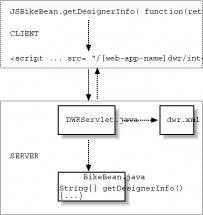Hack 43. Integrate DWR into Your Java Web Application
| Design your Ajax application around a JavaScript framework bound to Java objects on the server. The Direct Web Remoting code comes in the form of an archived or zipped Java Archive (JAR) file, dwr.jar. The download address is http://www.getahead.ltd.uk/dwr/download.html.
To get started with DWR, you must first set it up in your server-side web application. Place the dwr.jar file in the /WEB-INF/lib directory of your Java web application on the server, then restart or reload the application.
Configuring the ApplicationTo get DWR going with your JavaScript, you have to declare in web.xml a Java servlet that DWR uses. Here is the chunk of code that you have to add to web.xml. If web.xml already includes registered servlets, nest this newly declared servlet in with the existing ones (the same goes for the servlet-mapping element): <servlet> <servlet-name>dwr-invoker</servlet-name> <servlet-class>uk.ltd.getahead.dwr.DWRServlet</servlet-class> <init-param> <param-name>debug</param-name> <param-value>true</param-value> </init-param> </servlet> <servlet-mapping> <servlet-name>dwr-invoker</servlet-name> <url-pattern>/dwr/*</url-pattern> </servlet-mapping>
You also have to create a simple XML file declaring the Java classes that you want to use from your client-side JavaScript code. Don't worry, I'll show you how to use the JavaScript objects that are bound to Java classes shortly! The file is named dwr.xml. Place this XML file in /WEB-INF/: <dwr> <allow> <create creator="new" javascript="JsDate"> <param name="class" value="java.util.Date"/> </create> <create creator="new" javascript="JsBikeBean"> <param name="class" value="com.parkerriver.BikeBean"/> </create> </allow> </dwr> This XML states that the client-side JavaScript can use two Java classes remotely. The JavaScript objects that bind the client-side code remotely to the Java classes are named JsDate and JsBikeBean. As part of the server-side preparations, you must have already developed the Java class com.parkerriver.BikeBean and installed it in your application. java.util.Date is part of the Java software development kit; it's not your own custom class. Date is already available as part of the Java virtual machine your server component is using.
This XML file binds the two JavaScript names to the Date and BikeBean objects, so that these objects are available to use in your client-side JavaScript. This means that JavaScript code can call all the public methods of these Java objects. But how is the JavaScript in the local web page connected to the remote Java instances running on the server? Figure 5-1 shows in general terms the path a JavaScript method call takes in DWR's form of web remoting. Figure 5-1. Calling a Java method remotely The web page that will use DWR contains these script tags, which connect the JavaScript code via the DWR servlet to the server code: <script type="text/javascript" src="/[name of web app]/dwr/interface/JsBean.js"> </script> <script type="text/javascript" src="/[name of web app]/dwr/interface/JsDate.js"> </script> <script type="text/javascript" src="/[name of web app]/dwr/engine.js"></script> <script type="text/javascript" src="/[name of web app]/dwr/util.js"></script> Think back to the simple XML file that we just added to the web application. The first two script tags reference the JavaScript names we bound to the Java classes that we want to remote: JsBikeBean and JsDate. The XML file configured certain Java classes to be used with these names in JavaScript code. Remember the dwr.jar file that we installed in the web application? It contains two JavaScript libraries, engine.js and util.js. The first of these files is required to use DWR; the second is optional and contains a bunch of DWR functions that the client-side code can use. The URL that the script tag uses, such as /parkerriver/dwr/interface/JsBean.js, connects to the special DWR servlet that we enabled. The servlet in turn makes available to our code the public methods of the Java classes that we configured in XML. The next few hacks will use these classes and functions. |
EAN: 2147483647
Pages: 138
